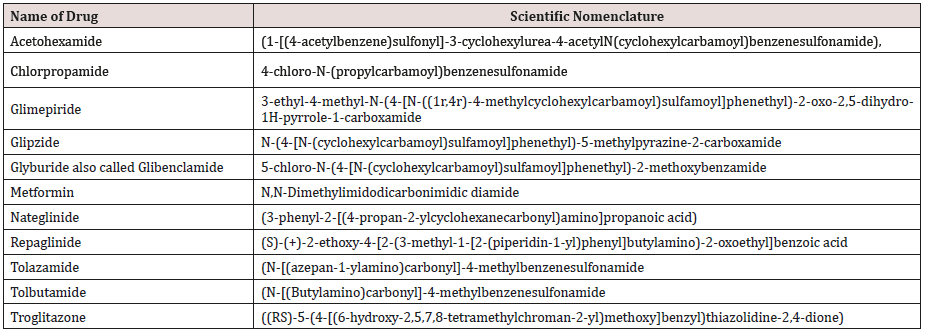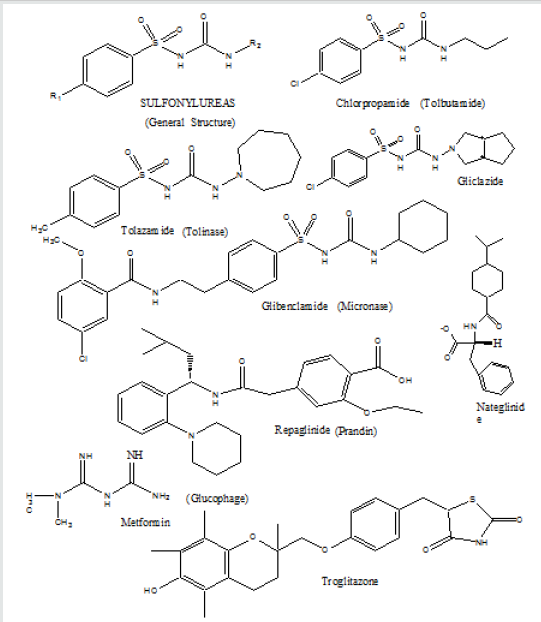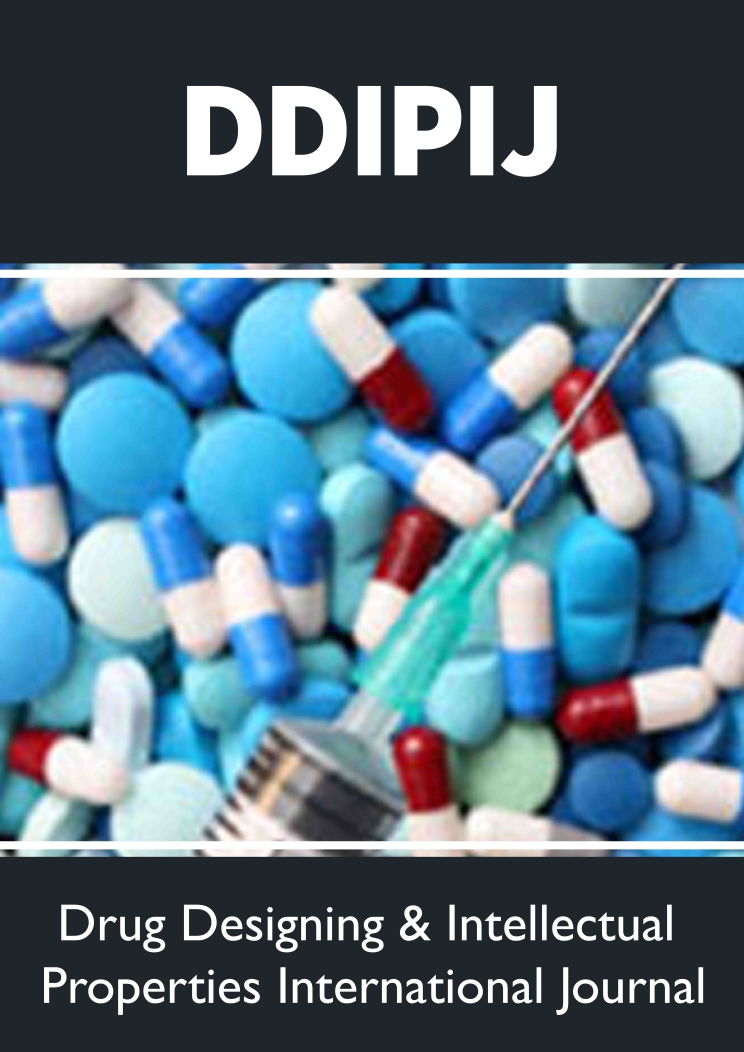
Lupine Publishers Group
Lupine Publishers
Menu
ISSN: 2637-4706
Mini Review(ISSN: 2637-4706) 
Antidiabetic Plant Extracts Volume 3 - Issue 1
Jagessar RC*
- Department of Chemistry, University of Guyana, South America
Received: April 08, 2019; Published: April 15, 2019
Corresponding author:Jagessar RC, Department of Chemistry, University of Guyana, South America
DOI: 10.32474/DDIPIJ.2019.03.000152
Abstract
Diabetes mellitus is a chronic health problem with long term consequences that are potentially preventable. It is a heterogeneous group of disease, characterized by high blood glucose levels resulting from impaired insulin secretion, impaired insulin action, or both. There are several synthetic antidiabetic drugs. These include Insulin Secretagogues (Sulfonylureas), biguanides, Thiazolidinediones, α- Glucosidase, Glucagon. Although, antidiabetic agents such as insulin, biguanides, thiazolidinediones and α glucosidase inhibitors are available in Guyana to treat diabetes, a safe and effective treatment paradigm is yet to be achieved. This is due to that fact that these drugs fail to significantly reduce the course of diabetic complications and have limited use because of their undesirable pathological conditions and high secondary failure rates. Therefore, it is essential to discover more effective antidiabetic agents with few adverse effects, low costs and ease of accessibility. In recent years, there has been a resurgence of interest in medicinal plants for the treatment of diseases. A World Health Organization (WHO) study shows that 80% of the world’s population solely relies on medicinal plants for their primary health care needs. Medicinal plant extracts, having antidiabetic properties can be a useful source for the development of oral hypoglycemic agents in both animal models and human subjects. Over 350 plants are used in the treatment of diabetes mellitus, but only a small number of these plants had gained scientific and medical evaluation to assess their effectiveness and efficacy
Keywords: Diabetes; Chronic; Synthetic antidiabetic drugs; World Health Organisation; WHO
Introduction
Diabetes mellitus is a chronic health problem with long term consequences that are potentially preventable. It is a heterogeneous group of disease, characterized by high blood glucose levels resulting from impaired insulin secretion, impaired insulin action, or both [1-4]. In a hyperglycemic state, the body tries to remove excess glucose by excreting in the urine. This increases urine output, causing glycosuria and result in frequent thirst. In addition, the body is deprived of glucose energy and seeks alternative energy sources such as fats and muscle tissues, leading to weight loss [5]. A diminishing growth effect and increased predisposition to certain infections, may also be present with chronic hyperglycemia [1]. These combinations along with polyuria, polydipsia, polyphagia, and blurry vision produces the common symptoms of diabetes [6]. As this disease progresses, vascular damage ensues leading to severe diabetic microvascular and macrovascular complications [7]. Therefore, diabetes covers a wide range of diseases which are the major causes of chronic morbidity and death in diabetic subjects [8].
Being described as the “the perfect epidemic” this condition affects an estimated 387 million people worldwide. According to the WHO [9], the incidence of diabetes has risen dramatically over the past years with a current prevalence of 9% and it is expected to affect more than 500 million adults by 2030. North America and the Caribbean are the regions with a higher prevalence of 11%, having 37 million people affected. In 2012, an estimated 1.5 million deaths were directly caused by diabetes, with 80% deaths occurring in low and middle-income countries [9-11].
There are several synthetic antidiabetic drugs. These include Insulin Secretagogues (Sulfonylureas), biguanides, Thiazolidinediones, α- Glucosidase, Glucagon [12] etc. The structure of some of these drugs are shown in Figure 1. The scientific name is given in Table 1. Interestingly, most of these drugs seem to incorporate the urea linkage.
Although, antidiabetic agents such as insulin, biguanides, thiazolidinediones and α glucosidase inhibitors are available in Guyana to treat diabetes, a safe and effective treatment paradigm is yet to be achieved. This is due to that fact that these drugs fail to significantly reduce the course of diabetic complications and have limited use because of their undesirable pathological conditions and high secondary failure rates. Therefore, it is essential to discover more effective antidiabetic agents with few adverse effects, low costs and ease of accessibility [12]. Synthetic drugs currently in use for diabetic treatment have undesirable side effects, including weight gain, hypoglycemia, nausea and diarrhea. These contributes a great deal to non-compliance in patients which can lead to further deleterious progression of their condition and result inevitably, in the increased mortality rate of the disease. For this reason, natural hypoglycemic compounds found in plant extracts present an attractive alternative to synthetic drugs or as reinforcements for currently used treatments.
In recent years, there has been a resurgence of interest in medicinal plants for the treatment of diseases [12]. A World Health Organization (WHO) study shows that 80% of the world’s population solely relies on medicinal plants for their primary health care needs [13]. Medicinal plant extracts, having antidiabetic properties can be a useful source for the development of oral hypoglycemic agents in both animal models and human subjects [1]. Over 350 plants are used in the treatment of diabetes mellitus, but only a small number of these plants had gained scientific and medical evaluation to assess their effectiveness and efficacy [5]. For the management of diabetes, the World Health Organization (WHO) has recommended the evaluation of traditional plant treatments as they are effective, non-toxic, with little or no side effects and are considered to be excellent candidates for oral therapy [6].
The anti-diabetic activity of Psidium guajava have been reported [7,9]. For example, a study to evaluate the hypoglycemic potential of the aqueous extract of Psidium guajava unripe fruit peel on blood glucose level (BGL) of normal and streptozotocin induced mild and severely diabetic rats has been undertaken. This study revealed that the fruit peel of P. guajava had marked hypoglycemic effect [7].
A study to test for the hypoglycemic potential of the ethanolic extract of Psidium guajava leaves on normal and alloxan induced diabetic rats have been reported[8]. After 21 days of administering the ethanolic leaf extracts, blood glucose was found to attain normal levels in the plasma of the Psidium guajava treated rats. However, in this study, adequate results were not obtained to indicate sufficient evidence of anti-hyperglycemic activity of Psidium guajava . Nevertheless, the study confirmed that P. guajava has some form of hypoglycemic action, as is evident in prior research carried out on the species [9,10].
The antidiabetic activity of T. indica extract (100mg/kg and 200mg/kg) and standard compound glibenclamide were investigated [11]. A significant decrease of blood glucose level in treated diabetic rats compared to untreated diabetic rats (227.10mg/dL), p < 0.01 was observed. The glibenclamide produced a reduction in blood glucose to 127.32mg/dL which was lower than the 100mg/kg dose, resulting in a decrease in blood glucose to 133.27mg/dL [13].
The hypoglycemic and hypolipidemic activities of an ethanolic extract of Averrhoa bilimbi Linn. leaves Italised Oxalidaceae in streptozotocin (STZ)-diabetic rats have been reported. The beneficial effects of the ethyl acetate fraction of A. bilimbi fruit (ABAEE) on the antioxidant/oxidant status in diabetes mellitus rats have also been reported [14,15].
Antidiabetic effect of the ethanolic extract of Phyllanthus emblica fruits in evan rats has been reported and is dose dependent [16]. The anti-hyperglycemic effect of Quercetin, a major constituent of the methanolic extracts of Phyllanthus emblica fruit in Streptozotocin (STZ) induced diabetic rats were determined[17].
The hypoglycemic effect of the aqueous extract of the fruits of Psidium guajava, Averrhoa bilimbi and the peel of Tamarindus indica on normoglycemic guinea pigs have been reported by us [18]. The guinea pigs were divided into three groups of three: control group, aqueous fruit extract treatment group at a dose of 6ml/kg) and glibenclamide treatment group (with the dose 2.5mg/ kg). Guinea pigs received treatment twice daily for 12 days for each fruit and peel. Blood glucose and body weight were measured before treatment and between three days interval. Additionally, each plant extract at the dose of 6ml/kg was orally administered for glucose tolerance test during 120 minutes study in comparison to glibenclamide at the dose of 2.5mg/kg. Administration of extracts of Psidium guajava, Tamarindus indica and Averrhoa bilimbi resulted in a marked hypoglycemic (reduction) activity in blood glucose levels when compared to the control and Glibenclamide treated group on the 12th day: Psidium guajava (90±3.0 to 75.7±3.5mg/ dL), Tamarindus indica (89.0±5.6 to 70.7±2.1mg/dL) and Averrhoa bilimbi (110.0±9.2 to 86.7±10.0mg/dL). Glibenclamide also resulted in a reduction (88.0±2.0 to 67.3±3.5mg/dL) as compared to the control.
There are several herbs that are used to treat diabetes locally and internationally [19-23]. Locally Momordica charantia [19], an herbaceous, tendril-bearing vine contains a compound called charantin, which have hypoglycaemic effect. It has been found to increase insulin sensitivity. A daily dose of 100mg per kilogram of body weight is comparable to 2.5mg/kg of the anti-diabetes drug glibenclamide taken twice per day. Other compounds in M.charantia have been found to activate the AMPK, the protein that regulates glucose uptake. The whole plant is used as a decoction for diabetes. The dry leaf and stem are boiled and the water drunk as an anti diabetic. The fruit is cooked and eaten as an anti diabetic. Use with almond oil for a vulnerary. Tablets of M.charantia extract are sold in the United Kingdom.
Phyllanthus niruri [19] contains alkaloids, flavonoids and triterpenes. The whole plant is used as a blood purifier (bitter tonic) to reduce blood sugar level. It’s available as capsules. Cajanus cajan [19], Pigeon peas contain high levels of protein and the important amino acids methionine, lysine, and tryptophan. Leaves and flowers are boiled for a diuretic and diabetes remedy. The whole plant of Desmodium barbatum [19] is use to reduced blood sugar level. The wood of the plant, Telitoxium [19] is used for diabetes. The active adaptogenic constituents of Tinospora cordifolia [19] are diterpenoid compounds: polyphenols, and polysaccharides, including arabinogalactan polysaccharide. T. crispa and T. rumphii are used in Thailand and Philippines for treatment of diabetes. A decoction of the leaves of Azadirachta indica [19], Neem is used as a bitter tonic for treating diabetes and jaundice [20]. Internationally, the juice of the leaves of Abrus precatorius are given to diabetic patients. Achyranthes aspera [21-23] is used as a decoction in the treatment of diabetes mellitus. Likewise, the roots of Catharanthus roseus is used as decoction in the treatment of diabetes mellitus. The entire plant of Centella asiatica [21-23], is also used as a decoction in the treatment of diabetes mellitus [18- 23]. Curcuma longa is a rhizomatous herbaceous perennial plant which is used in the treatment of diabetes mellitus. Phyllanthus emblica [21-23], edible fruits are antidiabetic in nature. Piper bettle [21-23] leaf extract is used in the treatment for diabetes mellitus. Sphaeranthus indicus [21-23].
Conclusion
Diabetes mellitus is a serious disease worldwide and results in a wide range of ailments in humans. Synthetic treatments include the use of Insulin Secretagogues (Sulfonylureas), biguanides, Thiazolidinediones, α- Glucosidase, Glucagon etc. However, there is a need to continue with herbal treatments. Herbal treatments include plant parts from Momordica charantia , Phyllanthus niruri, Cajanus cajan, Desmodium barbatum , Tinospora cordifolia, Azadirachta indica, Abrus precatorius, Catharanthus roseus, Centella asiatica, Curcuma longa, Phyllanthus emblica , Piper betle and Sphaeranthus indicus. Type II diabetes is most likely to be developed in regions where there sedentary mode of life and lack of physical exercise and the diet is mainly of the Fast Food type. Stress is another factor that contributes to diabetes. Unless effective prevention strategies are implemented, the incidence of diabetes in the world will continue to rise, increasing the already high socioeconomic burden on families and the National Health Care System.
References
- Ngugi MP, Njagi JM, Kibiti CM, Miriti PM (2012) Pharmacological Management of Diabetes Mellitus
- Krentz AJ, Bailey CJ (2005) Oral antidiabetic agents: Current role in type 2 diabetes mellitus. Drugs 65(3): 385-411.
- Cheng A (2005) Oral antihyperglycemic therapy for type 2 diabetes mellitus. Canadian Medical Association Journal 172(2): 213-226.
- Martins E (2014) The Growing Use of Herbal Medicines: Issues Relating to Adverse Reactions and Challenges in Monitoring Safety. Frontiers in Pharmacology 4: 1663-9812.
- Najmi A, Akhtar M, Mohd A, Mujeeb M, Pillai KK, et al. (2012) A pharmacological appraisal of medicinal plants with antidiabetic potential. Journal of Pharmacy And Bioallied Sciences 4(1): 27.
- WHO (2016) Genomic resource centre: Genes and human disease.
- Maritim AC, Sanders RA, Watkins JB (2003) Diabetes, oxidative stress, and antioxidants: A review. Journal of Biochemical And Molecular Toxicology 17(1): 24-38.
- Rai PK, Jaiswal D, Mehta S, Watal G (2009) Anti-hyperglycaemic potential of Psidium guajava raw fruit peel. Indian J Med Res 129(5): 561-565.
- Huang CS, Yin MC, Chiu LC (2011) Antihyperglycemic and antioxidant potential of Psidium guajava fruit in Streptozotozin induced diabetic rats. Food and Chemical Toxicology 49(9): 2189-2195.
- Banu MS, Sridharan SK, Manikandan R (2013) Antihyperglycemic and antihyperlipidemic potentials of Psidium guajava in alloxan-induced diabetic rats. Asian Journal of Pharmaceutical and Clinical Research 6(1): 88-89.
- Bhutkar MA, Bhise SB (2011) Anti-Oxidative Effect of Tamarindus Indica in Alloxan Induced Diabetic Rats. International Journal of Research in Pharmaceutical and Biomedical Sciences 2(3): 1006-1009.
- Trevor AJ, Katzung BG, Masters SB (2005) Katzung & Trevor Pharmacology (7th edn.), Lange Medical Books/ McGraw-Hill, USA, pp. 346-354.
- Martins E (2014) The Growing Use of Herbal Medicines: Issues Relating to Adverse Reactions and Challenges in Monitoring Safety. Frontiers in Pharmacology 4: 1663-9812.
- Pushparaj P, Tan CH, Tan BK (2000) Effects of Averrhoa bilimbi leaf extract on blood glucose and lipids in streptozotocin-diabetic rats. Journal of Ethnopharmacology 72(1-2): 69-76.
- Surya B, Kurup S (2017) Averrhoa bilimbi fruits attenuate hyperglycemiamediated oxidative stress in streptozotocin-induced diabetic rats. Journal of Food and Drug analysis 25(2): 360-368.
- Sultana Z, Jami S, Ali E, Begum M, Haque M (2014) Pharmacology & Pharmacy 5: 11-18.
- Srinivasan P, Vijayakumar S, Kothandaraman S, Palani M (2018) Antidiabetic activity of quercetin extracted from Phyllanthus emblica L. fruit: In silico and in vivo approaches. Journal of Pharmaceutical Analysis 8: 109-118.
- Jagessar RC, Rodrigues A, Prashad K, Husain A, Kanhai V, et al. (2018) An investigation of the hypoglycemic effect of the aqueous extract of the fruits of Psidium Guajava, Averrhoa bilimbi and the peel of Tamarindus indica in normoglycemic guinea pigs. World Journal of Pharmacy and Pharmaceutical Sciences. 7(4): 77-101.
- Kokwaro JO (2009) Medical Plants of the Guianas (Guyana, Surinam, French Guiana). pp. 94-189.
- Lachman-White DA (1992) A guide to the medicinal plants of coastal Guyana. Commonwealth Secretariat, London, UK, England, p. 26.
- Ediriweera ERHSS (2012) A Review on Herbs Used in Treatment of Diabetes Mellitus by Sri Lankan Ayurvedic and Traditional Physicians.
- Grimes M (2010) Herbs Help Treat Diabetes: Bilberry, Gymnema, Ginkgo and Salt Bush.
- Modak PDM (2012) Indian Herbs and Herbal Drugs Used for the Treatment of Diabetes. J Clin Biochem Nutr 40(3): 163-173.

Top Editors
-

Mark E Smith
Bio chemistry
University of Texas Medical Branch, USA -

Lawrence A Presley
Department of Criminal Justice
Liberty University, USA -

Thomas W Miller
Department of Psychiatry
University of Kentucky, USA -

Gjumrakch Aliev
Department of Medicine
Gally International Biomedical Research & Consulting LLC, USA -

Christopher Bryant
Department of Urbanisation and Agricultural
Montreal university, USA -

Robert William Frare
Oral & Maxillofacial Pathology
New York University, USA -

Rudolph Modesto Navari
Gastroenterology and Hepatology
University of Alabama, UK -

Andrew Hague
Department of Medicine
Universities of Bradford, UK -

George Gregory Buttigieg
Maltese College of Obstetrics and Gynaecology, Europe -

Chen-Hsiung Yeh
Oncology
Circulogene Theranostics, England -
.png)
Emilio Bucio-Carrillo
Radiation Chemistry
National University of Mexico, USA -
.jpg)
Casey J Grenier
Analytical Chemistry
Wentworth Institute of Technology, USA -
Hany Atalah
Minimally Invasive Surgery
Mercer University school of Medicine, USA -

Abu-Hussein Muhamad
Pediatric Dentistry
University of Athens , Greece

The annual scholar awards from Lupine Publishers honor a selected number Read More...







